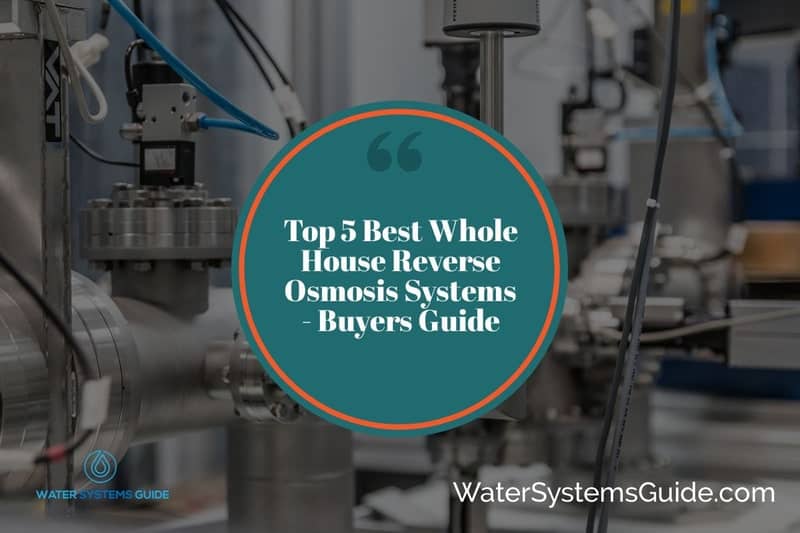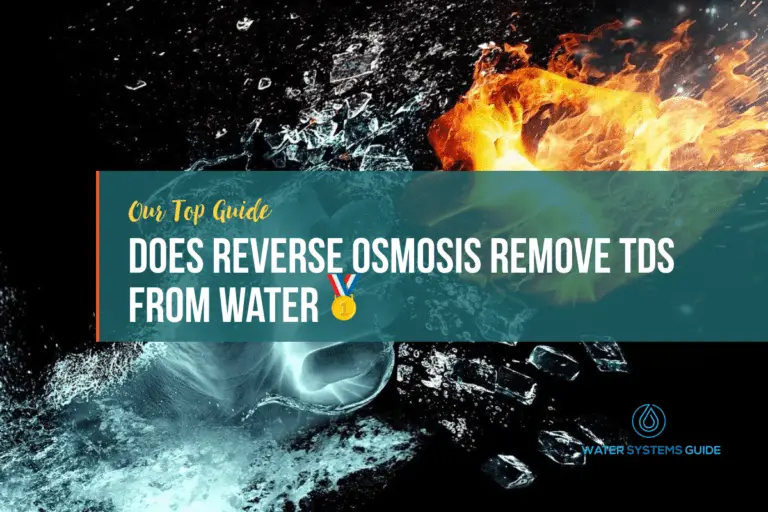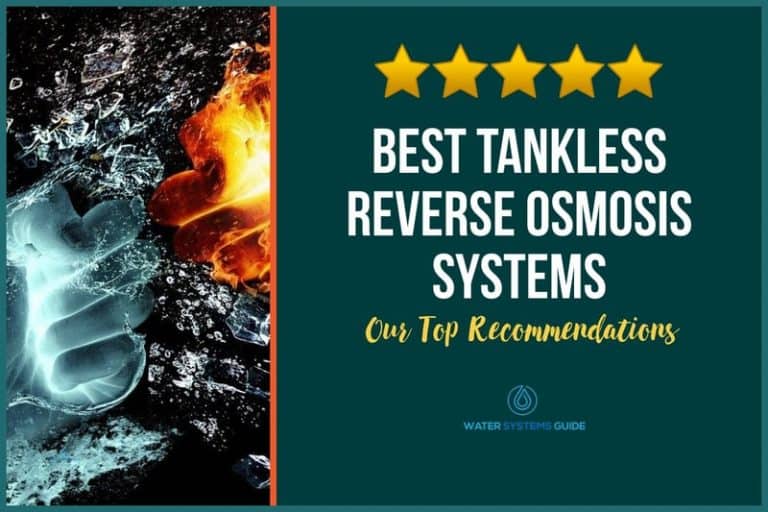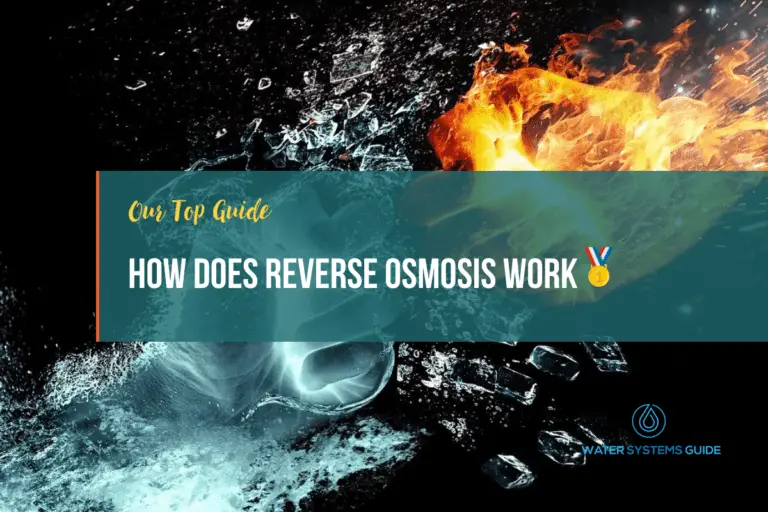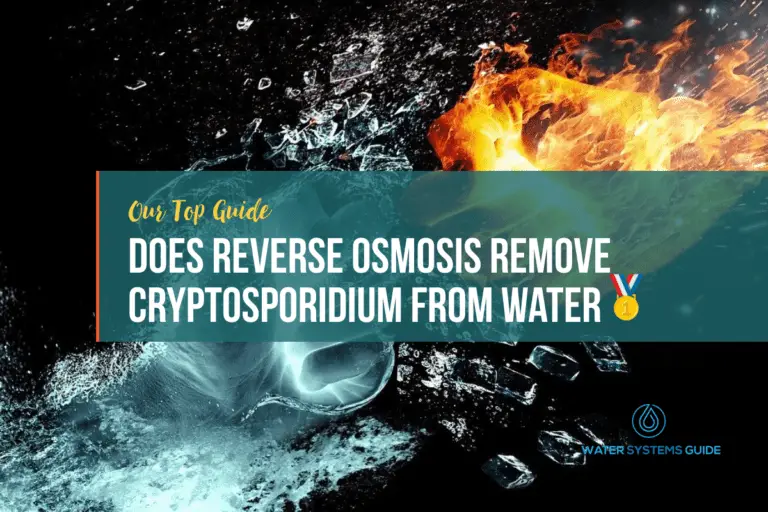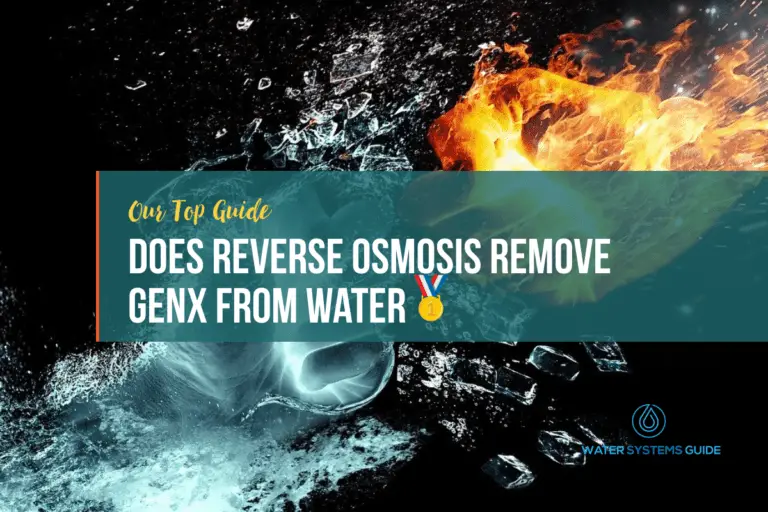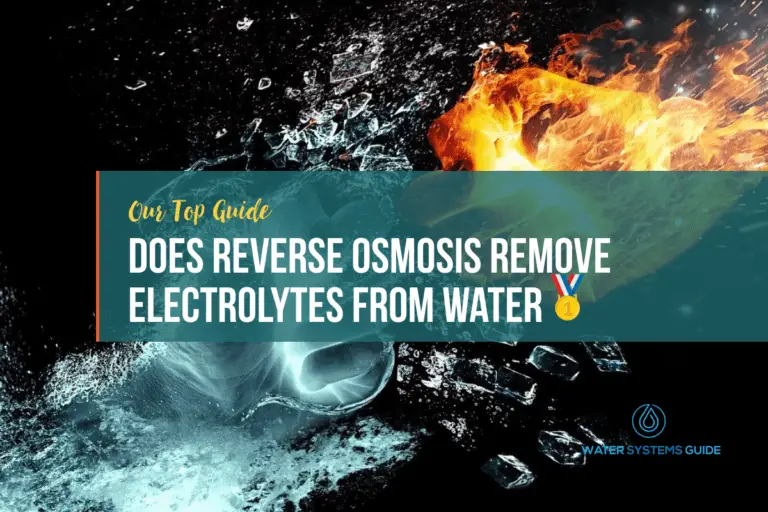Top 5 Best Whole House Reverse Osmosis Systems🥇(December 2025)
Last Updated: 24 December 2025
In this article, we’re going to be talking about the best Whole House RO Systems that are available on the market.
In the US, the water that comes out of our faucets is largely contaminated with particles, chemicals (most especially chlorine), and excess minerals due to environmental and industrial pollution. Fortunately, you can get a whole house reverse osmosis filtration system that can remove all these impurities. In this way, you can have access to clean and freshwater for your household or office!
A reverse osmosis water filter is one of the best ways to get safe water. If you want to know more about reverse osmosis filtration system, you have come to the right place! In this article, you will learn how one works, what each technical term means, the top-rated filter, and other essential information you need to know!
✅What is a Whole House Reverse Osmosis System?
More commonly known as whole house RO water filter system, Reverse Osmosis filtration system are mechanisms that use technology and a series of purifying water filters. In this type of water filter, water passes through a semipermeable membrane or a series of such to filter out, separate, and remove pollutants, contaminants, or particles.
While other standard water filtering systems can also achieve this, what sets whole house RO water filter systems apart is their ability to remove the smallest particles that are suspended or even dissolved in the water, like salt. This means that the final product has a superior and much better caliber.
A House RO water filter can remove particles as tiny as molecules, ions, and even a few types of bacteria or microorganisms from the water. This can help remove the foul smell or taste associated with pollution and can help provide potable water in places near industrial production plants or factories. RO systems can also produce freshwater from saltwater, wastewater treatment, and water recycling.
💧What to Consider Before Purchasing a Whole House RO System
RO water filter systems do not come cheap, especially whole house units. This is why you have to make an informed buying decision so as not to waste your precious money. To do this, consider the following:
Components Required
A whole house RO filter is not just composed of the water filter machine itself but has pre-treatment, post-treatment, and storage and distribution components as well. Most devices are also compatible with and require non-pressurized atmospheric storage tanks to store filtered water in so your home never runs out of clean water.
Because atmospheric tanks are not pressurized, the water needs to be repressurized to make it flow, a function for which a booster pump is necessary. Some devices operate better in tandem with pressurized bladder tanks.
In choosing a filter, therefore, you need to consider the quality of all these other components as much as that of the device itself.
Capacity
You also need the right capacity of a whole house RO water filter system to meet your needs. The size may also correspond to the capacity of the system. The average American uses an estimated amount of 80 to 100 gallons of water each day. So, a whole-house device for a family of 4 should at least be able to filter 320 gallons of water each day, (4 x 8).
Also, experts suggest that you adjust the size of your system such that it only runs at 75% or less of its maximum volume to provide for your needs. So, multiply that 320 GPD need by two, and you get a rating of 640 GPD. This means that a 640 GPD system would be ideal for a household of four people.
Note, also, that a filter rated at 500 GPD will not always deliver 500 gallons of water within 24 hours. These ratings reflect the capacities of the machine under optimum conditions. You can ask the seller or manufacturer about the actual output of your unit based on your water conditions.
You should also consider your family’s water consumption during peak hours, such as in the morning and at night. Make sure you have a large enough tank to store water. The volume of the tank should at least be your average consumption for a day.
Most commercial RO systems and commercial water filtration systems are tankless, meaning, your water is filtered on demand. In this case, you need to know the amount of clean water produced within a specific period of time. This rate is usually measured in gallons per minute (GPM). If the flow rate of your system is lower than what you require, there will be a drop in pressure.
Size
RO water filter systems come in all sorts of shapes and sizes. Make sure that the dimensions of your unit will fit in the space under your sink, as you would install an under sink water filter, or where you intend to install it. It’s best to measure and assess the space you have to accommodate the machine since these can be pretty large and heavy.
Pre-Treatment
Depending on the condition of your feed water, you will need an additional pre-treatment. This is also true for commercial versions with very fast flow rates. This not only ensures that your system will last for years but will also lessen the operating costs.
Pre-treatment usually involves the removal of larger particles and contaminants like sand, silt, and rust. A carbon backwashing filter can also remove chlorine and other chemicals. A water softener system or an antiscalant mechanism is needed in case of hard water that can damage and clog an RO membrane. Specialized water filters for sulfur, manganese, and iron is also ideal for well water.
We recommend having a water quality test conducted beforehand to know the condition of your feed water and the nature of its contaminants. For TDS higher than 2,000 ppm, discuss your next steps with a specialist.
Post-Treatment
An RO filter usually also have post-treatment water filters such as calcite filters. These raise the water’s pH to avoid the corrosion of fixtures and pipes that can affect the taste. This is necessary since RO membranes tend to reduce mineral content and make the water more acidic.
Aside from this alkalization, post-treatments may also involve UV light filtration to kill viruses and bacteria or adding back essential minerals to your water.
Installation and Maintenance
Generally, whole house RO systems are easy to install, and can be installed with a few tools and minimal skills, but that depends on the style and type. If you have the time, you can try and do it yourself or have it done by your contractor or plumber. Either way, look for devices that are simple and easy enough to install to avoid complications and wasted time.
Regarding maintenance, some need to be cleaned and have the activated carbon filters replaced every month while others only need a few replacements in a year. Afterall, you’re probably going to be using this to clean your drinking water, so it’s important to make sure that it’s regularly maintained. However, the crucial part is the cost of this replacement and maintenance that may accumulate over time.
Wastewater
For every gallon of purified water, six to eight gallons of water are wasted, costing a lot of money and a massive waste of resources. Fortunately, this only applies to the old RO water filter system models. Modern models are much more efficient and can achieve recovery rates of at least 33% (2:1 ratio).
Through the use of a recycle valve, some devices may allow the wastewater to run back into the system to get rates up to 70% (7:10 ratio) or more for multi-membrane types.
Wastewater can also accumulate in your septic system, in which case you may have to send it to a basement drain or a separate dry well.
🚰What is the Best Reverse Osmosis System for Home?
If reverse osmosis systems are new to you, it can be difficult, confusing, and overwhelming to choose the top best product for your office, school, or household. But don’t worry because I have great news for you!
Instead of having to pore over long lists of top options without a slight hint of what you’re looking for, we did the hard part for you! We narrowed down the best reverse osmosis systems into the top five best products.
We have chosen these based on Amazon customer reviews, arranged based on their price from lowest to highest. Listed below are the top 5 best RO systems as well as their specs descriptions, reviews, advantages, and disadvantages.
Whole House Reverse Osmosis Water Systems Review – Top 5
Before we get to the reviews, here is a comparison chart to help you compare and contrast the features of the top five RO systems listed here:
| Product Name | Capacity (GPD) | Pressure (PSI) | Number of Stages | Price |
| Reverse Osmosis Revolution 3/4″ Port 3-Stage House Filtration System | 100 | 20-100 PSI | 3 | $ |
| Light Commercial Reverse Osmosis Water Filtration System by Premier Water Systems | 400 | 22-95 PSI | 3 | $$$ |
| iSpring RCB3P Commercial Grade Reverse Osmosis System | 100-300 | 22-95 PSI | 5 | $$$ |
| iSpring RCS5T Tankless Reverse Osmosis Water Filtration System | 500 | 10-15 PSI | 5 | $$$ |
| WECO HydroSense-0500 Light Commercial Reverse Osmosis Filter System | 500 | 55-80 PSI | 4 | $$$$$ |
1. Reverse Osmosis Revolution 3/4″ Port 3-Stage House Filtration System
Technical specs
- Gallons per minute (GPM): 1-10 GPM
- Gallons per day (GPD): 100
- Water Pressure (PSI): 20-100 PSI
- Filtration Capacity (Stages) : 3
General specs
- Price: $
- Dimensions: 14.5 x 14.5 x 6 inches
- Weight: 16 pounds
- Kit Includes: water filtration system, 10” housing, extra set of filters made of carbon, ¾” port, 2 valves
- Warranty: One-year limited warranty
Description
While technically not a reverse osmosis water filter system (Reverse Osmosis Revolution is the brand name), this 3-stage house filter system is a top option if you want clean water at an affordable price.
It features three filtering phases. The first one is a 5-micron sediment filter that removes rust, silt, dirt, dust, and sand. The second filter is a 10” Granular Activated Carbon (GAC) filter that helps in eliminating radon, chlorine, volatile organic compounds (VOCs), and other chemicals. It helps remove unpleasant taste, discoloration, and foul odors.
The third and final stage is made of a premium 10” CTO Carbon block filter that also filters out chlorine and substances like industrial solvents, pesticides, insecticides, and other compounds. It also helps improve the taste of the water.
This filter uses a ¾” thread connection and semi-clear housings for durability and ease of maintenance. The semi-clear plastic allows you to see if the water filters already need to be replaced. This is usually after three to six months.
Pros:
- Great workmanship
- Excellent, affordable and reasonable price
- Easy to install and replace filters
- Works as advertised
- Works well in removing water smell and sediments
- Does not affect the water pressure
- Significantly improves water quality
Cons:
- Does not work very well in removing radon or sulfur smell according to reviews
- Leakage problems
2. Light Commercial Reverse Osmosis Water Filtration System by Premier Water Systems
Technical specs
- Gallons per minute (GPM): 0.3 GPM
- Gallons per day (GPD): 400
- Water Pressure (PSI): 22-95 PSI
- Filtration Capacity (Stages): 3
General specs
- Price: $$$
- Dimensions: 18 x 12 x 36 inches
- Weight: 38 pounds
- Kit Includes: water filtration system, booster pump, drain control valve, stand bracket, and housing wrench
- Warranty: One-year standard warranty
Description
Even though it is designed for commercial use in laboratories, cafes, restaurants, schools, offices, salons, and other establishments, you can use the Reverse Osmosis Water Filtration System by Premier Water Systems for your household.
It offers a water pressure of 22 to 95 PSI and flow rating of 400 thanks to four (with a rate of 100 each) high flow membranes. This product also features 20” pre RO carbon water filters that can filter a maximum of 30, 000 gallons of water. These water filters last longer and work twice as much as the industry standard 10” filters.
Because it also helps eliminates plastic, this system is also considered environmentally friendly. It is compatible with most storage tanks, but this particular kit does not include a tank. However, it does include two high flow pump that increases the water pressure and speeds up the purification or filtration process.
This reverse osmosis system also comes with a built-in 40/60 tank pressure switch which automatically turns the system on when the pressure in the tank drops below 40 PSI and shuts it off upon reaching 60 PSI of tank pressure.
Pros:
- Easy to operate
- Compact
- Easy to clean
- Durable premium filters
Cons:
- Does not come with instructions or product details based on user reviews
3. iSpring RCB3P Commercial Grade Reverse Osmosis System
Technical specs
- Gallons per minute (GPM): 0.07 – 0.2 GPM
- Gallons per day (GPD): 100-300
- Water Pressure (PSI): 22-95 PSI
- Filtration Capacity (Stages): 5
General specs
- Price: $$$
- Dimensions: 14 x 10 x 30 inches
- Weight: 52 pounds
- Kit Includes: water filtration system, booster pump, pressure gauge, and free-standing frame
- Warranty: Manufacturer one-year limited warranty
Description
Combining three high-efficiency reverse osmosis membranes with a flow rate of 100, this RO water system produces up to 300 gallons per day of water. This makes it ideal for application in a commercial building or a big household.
This reverse osmosis system removes heavy metals, toxins, hardness, chlorine, and other impurities. It also comes with a built-in pressure gauge and booster pump for the optimum water pressure to ensure an efficient reverse osmosis process. This also allows you to monitor when the water filters need replacement.
This system also features 20” oversized pre-filters that trap and remove twice as many water contaminants as other systems. This also means you do not need to change the filters as frequently.
The iSpring RCB3P also has a feed water pressure of 22 to 95 PSI and a fitting size of 0.25 inches which is compatible with most pressurized storage tanks. ⅜” fittings also help improve and boost the water flux rate.
Pros:
- Simple installation and straightforward setup
- Works as promised
- Best for light commercial use
- Good customer service
Cons:
- The unit is hefty
- Expensive
4. iSpring RCS5T Light Commercial and Residential Tankless Reverse Osmosis Water Filtration System
Technical specs
- Gallons per minute (GPM): 0.34 GPM
- Gallons per day (GPD): 500
- Water Pressure (PSI): 10-15 PSI
- Filtration Capacity (Stages): 5
General specs
- Price: $$$
- Dimensions: 15 x 8 x 18 inches
- Weight: 32.7 pounds
- Kit Includes: reverse osmosis water filter system, housings, filters, parts and tubings, faucet and mounting bracket
- Warranty: 30-day warranty against manufacturer defects
Description
Like the other iSpring RO system, the RCS5T offers impressive efficiency in producing clean and safe drinking water for most applications in your home, restaurant, or small business. It works at a maximum rate of 500 gallons per day.
While the actual output can vary depending on the temperature and other factors, a patented dual-flow Reverse Osmosis membrane ensures a consistent output and an impressive 1:1 drain to output ratio.
The five-stage filtration process helps remove up to 99% of about a thousand different kinds of contaminants including PFOS, PFOA, THMS, sulfur, arsenic, pesticides, pathogens, lead, fluoride, and chlorine.
With a separately sold storage tank, you can get a significantly better water flux and a stable supply of filtered water. Its automatic shutoff capability is one of its best features.
Pros:
- Easy to install and operate
- Does not use up too much electricity
- Easily replaceable and reasonably priced filters
- Improves water taste
- Auto Shut off
- Good customer support
Cons:
- No monitoring gadgets
- Would be more efficient with a tank
- Low water pressure
5. WECO HydroSense-0500 Light Commercial Reverse Osmosis Filter System
Technical specs
- Gallons per minute (GPM): 0.34 GPM
- Gallons per day (GPD): 500
- Water Pressure (PSI): 55-80 PSI
- Filtration Capacity (Stages): 4
General specs
- Price: $$$$$
- Dimensions: 15 x 20 x 34 inches
- Weight: 70 pounds
- Kit Includes: filtration unit, automated pressure sensors & pump
- Warranty: Limited one-year parts warranty
Description
Last but not the least, this Reverse Osmosis Filter system employs four different phases of filtration to give you pure drinking water suitable for various applications in aquariums, laboratories, medical offices, schools, hydroponic farms, and residential houses.
The first stage removes tiny particles like insects, insect parts, dust, rust, sand, and silt, so your water comes out clear, and the filter system is protected from clogging. Then, the water goes through a pair of five-micron activated carbon block cartridges that serve in the removal of foul taste and odor-causing chemicals like chlorine, sulfur, chloramine, and cancer-causing THMs.
These carbon cartridges also function in removing organic chemicals like insecticides, herbicides, pesticides, and other industrial chemicals. The actual reverse osmosis process begins by allowing the water to pass through a special membrane that filters 98.5% of water contaminants including heavy metals such as lead, lead fluoride, mercury, TDS, nitrates, benzene, salts, radon, and fluoride. The final product is clear, odor-free, purified water.
Thanks to the pressure sensors, the electric booster pumps are automated, so your system keeps performing in top condition. The whole system also comes pre-assembled.
Pros:
- Excellent whole-house residential RO unit
- Removes water hardness, fluorides, and nitrates
- Performs well
- Sufficient water pressure
Cons:
- Not difficult to set up but takes quite some time before smooth operation based on customer reviews
- More expensive than other units in this article
Conclusion
Overall, the top one best reverse osmosis water filtration system is the iSpring RCS5T! It has a high volume of 0.34 GPM or 500 gallons per day water output at a very reasonable price. It is also relatively compact and lightweight, while also being easy to install and operate.
The package includes the necessary parts and tubings, carbon filters, housings, a faucet, and a mounting bracket. While the system does not come with a tank that would potentially boost its top performance, you can easily find compatible tanks in the market. This way, you can achieve a stable water supply and a much better flow rate and pressure.
Unlike other RO water systems which use only three or four filtration stages, the iSpring RCS5T utilizes five steps to remove up to 99% of water contaminants. This ensures that your family will only use and consume safe and clean water.
If you find that the iSpring RCS5T does not have the right pressure rating, go for the WECO Hydrosense-0500 instead! While it costs much more and uses fewer filtration levels, it makes up for it in durability and pressure rating. Other than that, I’m sure this unit will work just as well for your house.
If you think none of the five products reviewed here really suits your needs and preferences, you can also always do your own research based on the concepts that we have discussed here. Don’t forget to keep all the necessary information in mind so you can still make the best buying decision for your water supply.
Frequently Asked Questions
💧How much is a reverse osmosis system for home?
There are several reasons why this is is a good investment; there are also reasons why you may not want to purchase it. For one, the price of these devices is no joke.
The cost varies significantly from $500 to $3,500 without the storage tank, a delivery pump, or the plumbing services for the installment. This, of course, depends on the level of purification, the volume, brand, and other factors.
A top-of-the-line house filter system can easily cost up to almost $1000 or more. However, if you think about it, the health of your family and the water quality it supplies to your house or business make these investments well worth their hefty price tags.
🚰How does a whole house RO system work?
A whole house RO system is the most convenient and cost-effective type of RO system device installation. This means that all the water from the main supply gets filtered and treated before it enters your home or property.
This system includes several components namely the pre-filtration system, the membrane chamber, an atmospheric storage tank, a repressurization pump and maybe even a calcite filter that reduces the acidity of the water or adds dissolved solids into it.
A whole house RO system aims to remove 98% to 99% of water contaminants so that the water consumed and used by your family is clean and safer. It is installed at the site where the water source enters your house, whether it comes from the municipal supply or a tank. The water then passes through a series of filters and membranes to have the contaminants removed. The pre-filtration stage will remove larger particles of rust, dust, sand, iron, sulfur, chlorine, manganese, or others.
Then, the water will be pressurized and passed through the semipermeable RO membrane. The lesser the water quality, the higher pressure is required. After that, the water is already demineralized and desalinated, which means most of the hardness is removed.
As the pressurized water passes through the membrane, the contaminants that are blocked are discharged by a different stream of water called the wastewater stream, which sends the dirty water to the drain or back to the main water supply.
💧Should you invest in a reverse osmosis system for your home?
Instead of worrying about the condition of water in your home, considering to buy an RO system may be a wiser decision. It will be a considerable investment, but it is worth it if you think of all the health problems that could arise from consuming dirty, contaminated water.
An RO system will help you protect the well-being and health of your family, especially if you have young children or family members who are sensitive to chemicals like chlorine. A whole house RO system will also resolve issues of high water hardness, chlorine content, sodium content, sulfate content, or TDS levels. It will also remove any unwanted smell or taste from the water.
🚰Do I need a whole house RO water system?
There are two types of RO systems; point of use (POU) system and whole house reverse osmosis system. POU systems are those installed at a specific place to acquire an excellent and clean water supply for a particular purpose. Usually, these are installed in the kitchen to provide water for cooking and drinking purposes.
This type of osmosis system, on the other hand, is installed near the main supply to provide better water throughout your entire household. In places where the water condition is very poor, this can be ideal. However, some say it is also impractical since then you would be using water suitable for all applications, including watering the plants and flushing the toilet. This is why a POU system is often used in combination with a water filtration system for the whole home according to user reviews.
💧What is the cost to replace the system’s filters?
Aside from considering the initial cost and installation cost of the system, you should also consider the cost of replacing and maintaining the water filters. Depending on the system type and volume, you may need to replace the carbon and other filters every few months or at least several times per year.
Cheaper models typically require more frequent filter replacements even though the initial cost is a lot more affordable. If you buy a cheaper model, therefore, there is a chance that you could end up spending more in the long run by having to purchase filter replacements.
There are also whole-house RO units that come with modular water filter designs that allow you to replace the filters along with the housing. This avoids germ accumulation in the purifier and takes much less time than having to clean out filters. However, modular replacement filters are more expensive than units with separate housings.
🚰What to Look for When Choosing a Whole House Reverse Osmosis System
There are several things to consider when choosing a whole house RO system. Before making a purchase, you need to ensure that the brand, model, and type of RO system you are buying will be the top one and most ideal option for your household.
Listed below are some of the most critical considerations and things to look for:
What type of system is it?
First, you need to consider what type of system it is and for what purpose it was made. Some systems are specifically manufactured for heavy-duty or industrial applications for larger businesses and plants while others have the standard volume and meant for domestic or light commercial use.
What you would usually need in your home is a light commercial type of system that will be able to sustain your family’s regular daily water consumption as well as to adapt during times of peak usage. These also work great for homes connected or with the same water supply as small businesses or restaurants.
What is the micron rating of the filter?
Unit of measurement used to describe filters is a micron, which is equal to one-millionth of a meter in length. For water filters, this describes the diameter of the pores. For example, a 5-micron filter has pores with a diameter of 5 microns each. This also means that it can remove or filter contaminants and sediments that are as small as 5 microns.
The smaller the micron rating of a filter, the more particles it can remove.
What is the water flow rate?
This is measured in gallons per day or gallons per minute (GPM). This tells you how much water your RO system can process within a day. An average household of a family of 4 will only need about 300 to 400 of flow rate. You can adjust it depending on the needs of your own household.
Typically, a 500 Gallons-per-day rate is sufficient for most commercial and residential applications.
What is the water pressure?
Most reverse osmosis filters require a minimum of 40 pounds per square inch (PSI) for efficient operation. Almost all municipal water supplies have great water pressures, but this can significantly decrease as the water passes through a reverse osmosis system. If you get water from a private well, make sure you use a pump before the pressure of your water supply drops below 40 PSi. Otherwise, your water filtration system may not work correctly or not work altogether. A well water pressure tank will allow you to adjust the pressure using a switch. This way, you can ensure that the water pressure is always more than 40 PSI.
What is the quality of water?
This differs vastly depending on the state or region where your house is located. Your first assignment is to find out which contaminants are found in your water. Then, make sure your reverse osmosis system can remove those contaminants from the water.
So those are all the considerations you need to keep in mind before making a purchase, aside from the ones previously mentioned in the beginning sections. I hope you learned a lot and understood much of the information you have seen here. With the right knowledge and a narrowed list of buying options, it will be easier for you to choose the best RO system for your family or business.
💧What are the benefits of using a whole house reverse osmosis system?
There are multiple benefits of using a reverse osmosis system in your home. These include the following:
Better Tasting Food and Water
Removing all the sediments, contaminants, and chemicals (especially chlorine) in the water can significantly improve its taste. Whole house reverse osmosis system is much better-tasting than tap water and is also more satisfying and refreshing. Because you also use it for cooking, your food will not only be cleaner and safer but also more delicious.
Reduced Health Risks
The filtration process of whole house reverse osmosis removes impurities, particles, pollutants, and other substances (like chlorine) that can be harmful to your health. Some parasites and sickness-causing microorganisms from your drinking water can also be filtered out. This helps protect the well-being and health of you and your family.
Reduced Energy Consumption
RO systems use a relatively lower amount of energy than similar filter systems, which makes them ideal for those who want to save energy.
Various Levels of Purification
RO involves multiple house filtration steps that can be customized according to your needs. Each system is created differently, and the more filtration phases involved, the better the caliber of water you can get.
Money Savings
Out of all water treatment systems and methods, reverse osmosis removes the broadest spectrum of contaminants at the lowest costs with a contaminant removal of 95 to 99.99%.
So, not only do you not have to buy bottled water anymore but you also save a lot of money in the long run by dodging hospital bills.
Healthier Skin and Hair
When you use softer water that is devoid of any harmful chemicals, such as chlorine, you can also get smoother, healthier skin and hair with the use of an RO system.
Removal of Fluoride
Fluoride can help against cavities and tooth decay. However, this can also lead to a whole host of other problems like brain damage, harm to the joints and bones, and lower IQ when consumed regularly. Fluoride is present and is even added to public water, but an RO system can remove up to 90% of your water supply’s fluoride content.






